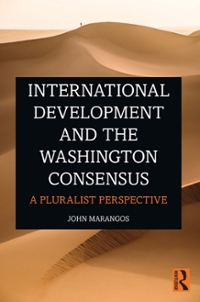.Solve all correctly.
7. AMCO International, a major apparel retail company, has several stores in the United States and in countries throughout the globe. It imports most of its apparel products and garments from overseas suppliers. To improve its global supply chain operations, the company wants to contract with a single supplier located in one of the major ports around the world who can supply the majority of the apparel products it needs. The company is considering five major garment and apparel suppliers in the following major port cities: Chennai, India; Chittagong, Bangladesh; Manila, Philippines; Shanghai, China; and Jakarta, Indonesia. AMCO International has estimated the future profits (or loss) it may achieve will depend on a variety of future conditions (states of nature) including market conditions, exchange rates, quality of second- and third-tier suppliers, security issues, port capacity, and ship and container availability. These future conditions can be classified into three categories: status quo (no change), favorable, and unfavorable. Table F.22 summarizes the payoffs (in $ millions) from each of the overseas suppliers for the three different states of nature. Table F.22: Payoff Matrix for AMCO International Table F.22: Payoff Matrix for AMCO International States of Nature Decision Alternative Status Quo Favorable Unfavorable Chennai $38 $75 -$40 Chittagong $22 $45 -$17 Manila $27 $60 -$23 Shanghai $37 $70 -$44 Jakarta $40 $55 -$32 Determine the best choice of supplier for each of the following decision criteria: a. The Laplace criterion b. The maximin criterion c. The maximax criterion d. The Hurwicz criterion (a = 0.3) e. The minimax regret criterion2. Suppose that you are given the aggregate production function for Canada: Y = AKON 1-a The assumptions of the Solow Growth Model hold. The parameter values are: a = 0.5 s = 0.45 6 = 0.1 n = 0.05 A = 2 a) What is the per capita production function? Hint: Divide the aggregate production function by N and express it in terms of k = KN . b) Recall that S = sY in the model. What is the per capita law of motion for capital? Hint: I am asking for k 0 as a function of k. Also, S = I in equilibrium. c) What is the steady state capital stock, output and consumption? d) Use the key growth model diagram to depict the steady state. Suppose that k starts below k ss. Show using arrows how it will grow over time towards the steady state. e) Show the effects on your diagram the effects of a decrease in productivity. What effect will this have on consumption, capital and output per capita? You do not have to re-solve the model. Just discuss the effects. f) Suppose that Canada and South Korea each have the same productivity: ^ACanada = ^ASouth Korea As well, the per capita capital stock is bigger in Canada: ^kCanada > ^kSouth Korea Which country to you expect to grow quicker in per capita terms? Discuss why. g) Suppose that Sierra Leone has a lower producitivity than Canada. Which country to you expect to have a higher per capita capital stock? Explain why(?) + SRPG 2021 A LRPC INFLATION RATE (Percent) UNEMPLOYMENT RATE (Percent) Based on your answers to the previous questions, use the black line (plus symbol) to draw the short-run Phillips curve for this economy in 2021 (SRPC2021. The short-run Phillips curve is line: o At Natural Real GDP At the natural rate of unemployment o Representing the tradeoff between unemployment and inflation Now consider the long-run effects of this policy. Suppose, in particular, that following Implementation of the policy, the aggregate demand curve remains at ADB. Designate the long-run equilibrium that would follow such a policy as outcome C. Going back to the first graph, place the grey point (star symbol) at outcome C. Because output at point C is Natural Real GDP, the unemployment rate associated with outcome C is the natural rate of unemployment. Finally, use the green line (triangle symbol) to draw the long-run Phillips curve (LRPC) on the second graph. This line is line: At Natural Real GDP At the natural rate of unemployment Representing the tradeoff between unemployment and inflation5. Consider a Solow growth model with population growth rate n > 0. Assume the technology growth rate is 0. Let k*(s) be the steady-state capital-labor ratio given savings rate s. (a) Show that the steady-state capital-labor ratio k* (s) is increasing in the savings rate s. (b) Express the steady-state per-capita consumption c* as a function of savings rate s. (c) Using the function above, express the condition for the savings rate s* that maximizes the steady-state per-capita consumption (i.e., what condition(s) would s* have to satisfy?). (Such a savings rate is called the golden-rule savings rate.) (d) Assume Cobb Douglas production function F(K, L) = KoLl-a where 0











